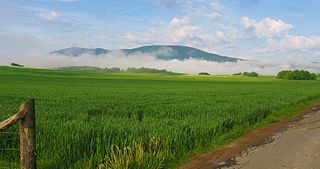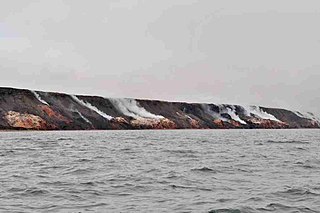
Coal is a combustible black or brownish-black sedimentary rock, formed as rock strata called coal seams. Coal is mostly carbon with variable amounts of other elements, chiefly hydrogen, sulfur, oxygen, and nitrogen. Coal is a type of fossil fuel, formed when dead plant matter decays into peat and is converted into coal by the heat and pressure of deep burial over millions of years. Vast deposits of coal originate in former wetlands called coal forests that covered much of the Earth's tropical land areas during the late Carboniferous (Pennsylvanian) and Permian times. Many significant coal deposits are younger than this and originate from the Mesozoic and Cenozoic eras.

Centralia is a borough and near-ghost town in Columbia County, Pennsylvania, United States. It is part of Northeastern Pennsylvania. Its population has declined from 1,000 in 1980 to five residents in 2020 because a coal mine fire has been burning beneath the borough since 1962. Centralia, part of the Bloomsburg–Berwick metropolitan area, is the least-populated municipality in Pennsylvania. It is completely surrounded by Conyngham Township.

Saarbrücken is the capital and largest city of the state of Saarland, Germany. Saarbrücken is Saarland's administrative, commercial and cultural centre and is next to the French border.

Coal mining is the process of extracting coal from the ground. Coal is valued for its energy content and since the 1880s has been widely used to generate electricity. Steel and cement industries use coal as a fuel for extraction of iron from iron ore and for cement production. In the United Kingdom and South Africa, a coal mine and its structures are a colliery, a coal mine is called a 'pit', and the above-ground structures are a 'pit head'. In Australia, "colliery" generally refers to an underground coal mine.

A coal-seam fire is a burning of an outcrop or underground coal seam. Most coal-seam fires exhibit smouldering combustion, particularly underground coal-seam fires, because of limited atmospheric oxygen availability. Coal-seam fire instances on Earth date back several million years. Due to thermal insulation and the avoidance of rain/snow extinguishment by the crust, underground coal-seam fires are the most persistent fires on Earth and can burn for thousands of years, like Burning Mountain in Australia. Coal-seam fires can be ignited by self-heating of low-temperature oxidation, lightning, wildfires and even arson. Coal-seam fires have been slowly shaping the lithosphere and changing atmosphere, but this pace has become faster and more extensive in modern times, triggered by mining.

The Hoher Meißner is a mountain massif with a height of 753.6 m and is located in the Meißner-Kaufunger Wald nature park in Hesse, Germany.

Burning Mountain, the common name for Mount Wingen, is a hill near Wingen, New South Wales, Australia, approximately 224 km (139 mi) north of Sydney just off the New England Highway. It takes its name from a smouldering coal seam running underground through the sandstone. Burning Mountain is contained within the Burning Mountain Nature Reserve, which is administered by the NSW National Parks and Wildlife Service (NPWS).

The Yacolt Burn is the collective name for dozens of fires in Washington state and Oregon occurring between September 8 and September 12, 1902, causing 38 deaths in the Lewis River area, at least nine deaths by fire in Wind River and 18 deaths in the Columbia River Gorge.

Neunkirchen is a town and a municipality in Saarland, Germany. It is the largest town in, and the seat of the district of Neunkirchen. It is situated on the river Blies, approx. 20 km northeast of Saarbrücken. With about 50,000 inhabitants, Neunkirchen is Saarland's second largest city.

A beehive oven is a type of oven in use since the Middle Ages in Europe. It gets its name from its domed shape, which resembles that of a skep, an old-fashioned type of beehive.

The Centralia mine fire is a coal-seam fire that has been burning in the labyrinth of abandoned coal mines underneath the borough of Centralia, Pennsylvania, United States, since at least May 27, 1962. Its original cause and start date are still a matter of debate. It is burning in underground coal mines at depths of up to 300 ft (90 m) over an 8 mi (13 km) stretch of 3,700 acres (15 km2). At its current rate, it could continue to burn for over 250 years. It has caused most of the town to be abandoned: by 2017, the population had dwindled to 5 residents from around 1,500 at the time the fire is believed to have started, and most of the buildings have been razed.

The Smoking Hills are located on the east coast of Cape Bathurst in Canada's Northwest Territories, next to the Arctic Ocean and a small group of lakes. The cliffs were named by explorer John Franklin, who was the first European to see them on his 1826 expeditions. They contain strata of hydrocarbons, which have been burning continuously for centuries.

A wood-burning stove is a heating or cooking appliance capable of burning wood fuel and wood-derived biomass fuel, such as sawdust bricks. Generally the appliance consists of a solid metal closed firebox, often lined by fire brick, and one or more air controls. The first wood-burning stove was patented in Strasbourg in 1557. This was two centuries before the Industrial Revolution, so iron was still prohibitively expensive. The first wood-burning stoves were high-end consumer items and only gradually became used widely.

The Bode Gorge is a 10 kilometres (6.2 mi) long ravine that forms part of the Bode valley between Treseburg and Thale in the Harz Mountains of central Germany. The German term, Bodetal, is also used in a wider sense to refer to the valleys of the Warme and Kalte Bode rivers that feed the River Bode.

"Welcome and Farewell" is a poem by Johann Wolfgang von Goethe from the collection Sesenheimer Lieder. It was published for the first time in 1775 in the women's magazine Iris. Franz Schubert set it to music as a lied (D.767).

The Blair Athol Coal Mine is a coal mine located in the Bowen Basin of Central Queensland, Australia. It is located over the former site of the township of Blair Athol. The mine has coal reserves amounting to 195 million tonnes of thermal coal, one of the largest coal reserves in Asia and the world. The mine has an annual production capacity of 12.9 million tonnes of coal.
The Laurel Run mine fire is an underground mine fire near the communities of Laurel Run and Georgetown, in Luzerne County, Pennsylvania, in the United States. The fire started burning in 1915 at the Red Ash Coal Mine. Attempts to control it lasted from 1915 to 1957 and recommenced in 1966. In the 1960s, the United States government and the Pennsylvania state government became involved in containing the fire. Attempts at stopping the spread of the fire were erroneously declared successful in 1973, and the fire is still burning.
The Carbondale mine fire was a mine fire in the West Side neighborhood of Carbondale, Lackawanna County, Pennsylvania in the United States. The fire, which started in 1946 and was eventually contained by the 1970s, caused at least two fatalities and millions of dollars of property damage.

The Luisenthal mine disaster was the most serious mine accident in the history of the Federal Republic of Germany. The explosion killed 299 miners.
The Hill End Colliery fire was an underground coal-seam fire. it burned from, at latest, August 1930 to at least early 1945, and most probably as late as June 1949. The impact of the fire was magnified by its close proximity to the mining town of Cessnock, New South Wales, Australia. The worst and most spectacular outbreak of the fire occurred on 8, 9 and 10 March 1933.

















